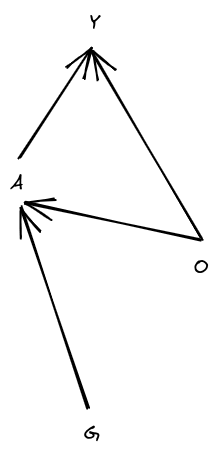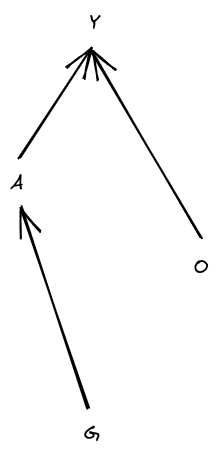So there’s this thing where a system can perform more bits of optimization on its environment by observing some bits of information from its environment. Conjecture: observing an additional bits of information can allow a system to perform at most additional bits of optimization. I want a proof or disproof of this conjecture.
I’ll operationalize “bits of optimization” in a similar way to channel capacity, so in more precise information-theoretic language, the conjecture can be stated as: if the sender (but NOT the receiver) observes bits of information about the noise in a noisy channel, they can use that information to increase the bit-rate by at most bits per usage.
For once, I’m pretty confident that the operationalization is correct, so this is a concrete math question.
Toy Example
We have three variables, each one bit: Action (), Observable (), and outcome (). Our “environment” takes in the action and observable, and spits out the outcome, in this case via an xor function:
We’ll assume the observable bit has a 50/50 distribution.
If the action is independent of the observable, then the distribution of outcome is the same no matter what action is taken: it’s just 50/50. The actions can perform zero bits of optimization; they can’t change the distribution of outcomes at all.
On the other hand, if the actions can be a function of , then we can take either or (i.e. not-), in which case will be deterministically 0 (if we take ), or deterministically 1 (for ). So, the actions can apply 1 bit of optimization to , steering deterministically into one half of its state space or the other half. By making the actions a function of observable , i.e. by “observing 1 bit”, 1 additional bit of optimization can be performed via the actions.
Operationalization
Operationalizing this problem is surprisingly tricky; at first glance the problem pattern-matches to various standard info-theoretic things, and those pattern-matches turn out to be misleading. (In particular, it’s not just conditional mutual information, since only the sender - not the receiver - observes the observable.) We have to start from relatively basic principles.
The natural starting point is to operationalize “bits of optimization” in a similar way to info-theoretic channel capacity. We have 4 random variables:
- “Goal”
- “Action”
- “Observable”
- “Outcome”
Structurally:

(This diagram is a Bayes net; it says that and are independent, is calculated from and and maybe some additional noise, and is calculated from and and maybe some additional noise. So, .) The generalized “channel capacity” is the maximum value of the mutual information , over distributions .
Intuitive story: the system will be assigned a random goal , and then take actions (as a function of observations ) to steer the outcome . The “number of bits of optimization” applied to is the amount of information one could gain about the goal by observing the outcome .
In information theoretic language:
- is the original message to be sent
- is the encoded message sent in to the channel
- is noise on the channel
- is the output of the channel
Then the generalized “channel capacity” is found by choosing the encoding to maximize .
I’ll also import one more assumption from the standard info-theoretic setup: is represented as an arbitrarily long string of independent 50/50 bits.
So, fully written out, the conjecture says:
Let be an arbitrarily long string of independent 50/50 bits. Let , , and be finite random variables satisfying
and define
Then
Also, one slightly stronger bonus conjecture: is at most under the unconstrained maximal .
(Feel free to give answers that are only partial progress, and use this space to think out loud. I will also post some partial progress below. Also, thankyou to Alex Mennen for some help with a couple conjectures along the path to formulating this one.)


The important thing is that your relevant information isn't about the state of the world, it's about the laws. That's the evolution map f, not the region O (going by the nomenclature I used in my other comment). Your knowledge about O when using the Haber process is actually roughly proportional to the output: you need to know that inside tank X there is such-and-such precursor, and it's pure to a certain degree. That's like knowing that a certain region of the bit string is prepared purely with 1s. But the laws are an interesting thing because they can have regularities (in fact, we do know they have them), so that they can be represented in compressed form, and you can exploit that knowledge. But also, to actually represent that knowledge in bits of world-knowledge you'd need to represent the state of all the experiments that were performed and from which that knowledge was inferred and generalized. Though volume wise, that's still less than the applications... unless you count each application also as a further validation of the model that updates your confidence in it, at which point by definition the bits of knowledge backing the model are always more than the bits of order you got out of it.